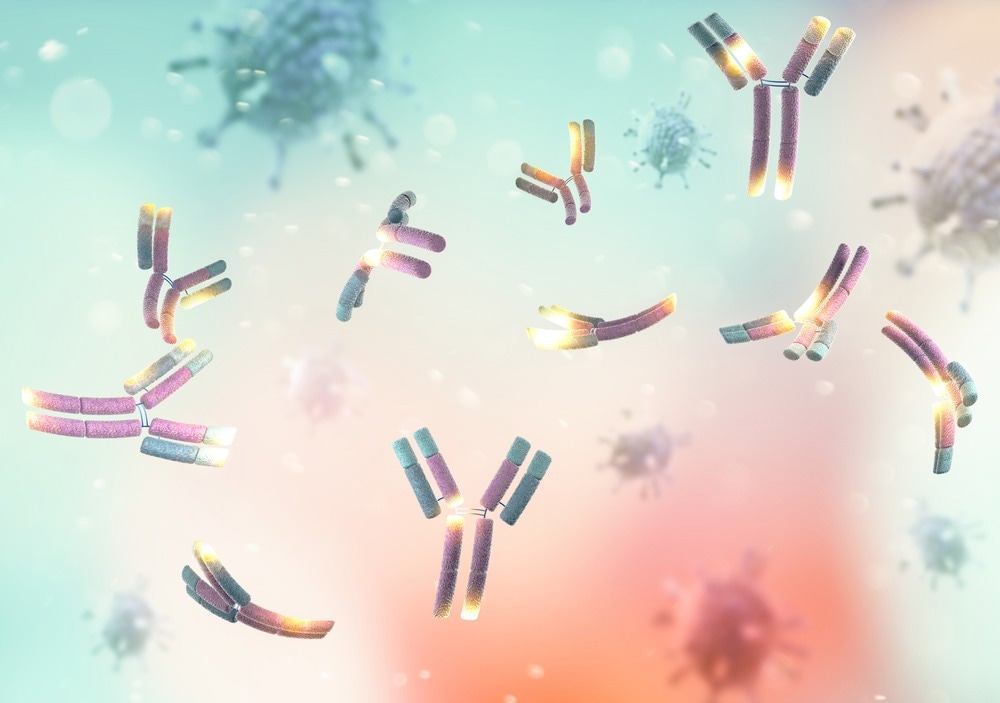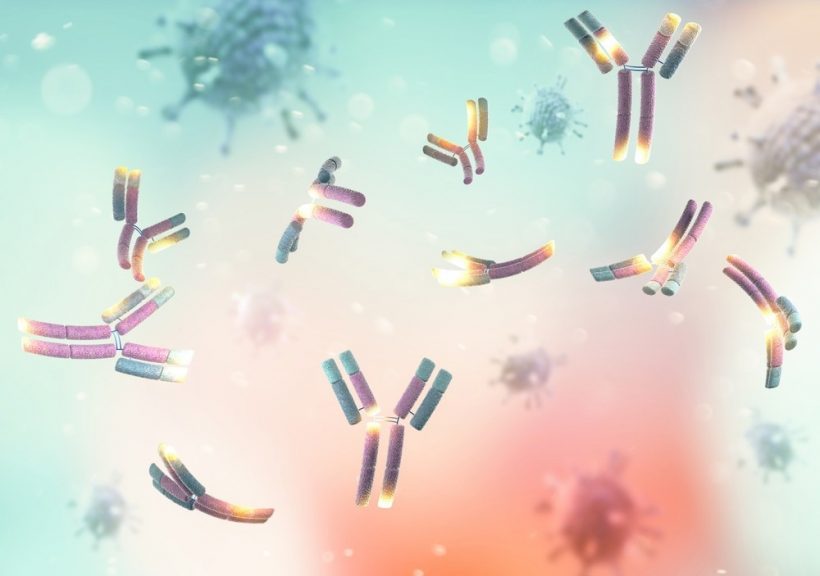In a recent study posted to the bioRxiv* preprint server, researchers demonstrated differential utilization of the B cell germlines and severe acute respiratory syndrome coronavirus 2 (SARS-CoV-2) spike (S) protein epitopes by cross-neutralizing antibodies (nAbs) in infected, vaccinated and individuals with hybrid immunity.

Background
SARS-CoV-2 Omicron sublineages BA.4 and BA.5 are the currently circulating variants worldwide. The lack of the G496S mutation in their S protein increased their human angiotensin-converting enzyme 2 (hACE2) binding affinities compared to other Omicron sub-variants. Moreover, they have evolved to suppress the host's innate immune defenses. It is crucial to understand the mechanisms employed by BA.4/BA.5 to escape natural and vaccine-induced immunity to devise measures to cease their relentless rampaging.
About the study
In the present study, researchers used a panel of 482 human monoclonal antibodies (mAbs) that neutralized the original Wuhan-Hu1 SARS-CoV-2 strain to evaluate their neutralizing activity against Omicron BA.4 and BA.5 sub-variants.
They used sera from three different cohorts to develop the study mAb panel: i) SARS-CoV-2 seronegative subjects vaccinated with two doses of any messenger ribonucleic acid (mRNA) coronavirus disease 2019 (COVID-19) vaccine (SN2), ii) SARS-CoV-2 seronegative subjects vaccinated with three doses of any mRNA vaccine (SN3), and iii) SARS-CoV-2 seropositive subjects were infected and subsequently vaccinated with two doses of any mRNA vaccine (SP2).
The researchers used a cytopathic effect-based microneutralization assay (CPE-MN) to test the neutralizing potential of the mAb panel against BA.4 and BA.5.
Study findings
Less than 15% of the mAbs retained a neutralizing activity against the Omicron BA.4 and BA.5 subvariants. While none of the 52 antibodies from the SN2 cohort were able to neutralize Omicron BA.4 and BA.5 subvariants, the authors noted a minimal cross-protection against BA.1 and BA.2. Conversely, 14.6% and 14.1% of the 206 nAbs, derived from the SN3 cohort, cross-neutralized Omicron BA.4 and BA.5, respectively. Similarly, 15.5% and 14.6% of the 224 SP2-derived nAbs cross-neutralized BA.4 and BA.5 subvariants, respectively. Notably, none of the nAbs tested showed extremely potent neutralization activity against all Omicron sublineages. Of the therapeutic mAbs, only LY171 CoV1404 or Bebtelovimab showed high neutralization potency against all Omicron sublineages. It had 100% inhibitory concentration (IC100) values of 11.1, 15.6, 44.2, and 62.5 ng ml-1 against Omicron BA.1, BA.2, BA.4, and BA.5, respectively.
The study analyses also revealed that two doses of an mRNA COVID-19 vaccine could not mount an adequate antibody response against Omicron sub-variants. However, three mRNA vaccine doses and hybrid immunity induced similar protection against the Omicron subvariants, with an overall average of 18.9 and 17.5% of SN3 and SP2-derived nAbs able to neutralize BA.4 and BA.5, respectively.
Further, the study analyses revealed striking differences in the B cell germline profiles behind these similar responses. A three-dose regimen of an mRNA vaccine mainly enhanced receptor-binding domain (RBD)-targeting Class I and II nAbs and showed a more clonal B cell response. The B cell response comprised five B cell germlines (IGHV1-58; IGHJ3-1, IGHV1-69; IGHJ3-1, IGHV1-69; IGHJ4-1, IGHV3-66; IGHJ4-1 and IGHV3-66; IGHJ6-1) which represented almost 60% of all Omicron cross-neutralizing antibodies. Interestingly, two of the five B cell germlines encoding for cross-neutralizing nAbs in the SN3 cohort viz., IGHV1-69: IGHJ4-1 and IGHV3-66: IGHJ4-1, were also present in the SN2 cohort but here they displayed no functional activity against Omicron sub-variants.
Conclusions
Overall, the study results indicated that a third mRNA vaccine dose (booster) enhanced the B cell affinity maturation of specific germlines and their expansion and subsequent production of cross-reactive nAbs. For hybrid immunity, B cell response was much more diversified and preferentially used RBD-directed Class III and N-terminal domain (NTD)-targeting nAbs. Therefore, only three B cell germlines, namely IGHV1-24:IGHJ6-1, IGHV1-58:IGHJ3-1, and IGHV2-5:IGHJ4-1, which represent around 31% of the whole nAb response, constituted a response against the Omicron sub-variants.
The study raised questions about the mechanisms of antigen presentation during the immune response to SARS-CoV-2 infection and vaccination. The authors observed homologous mRNA vaccination and SARS-CoV-2 infection resulted in the expansion of different B cell germlines, which produced nAbs targeting different epitopes on the SARS-CoV-2 S protein.
It is noteworthy that following SARS-CoV-2 infection and vaccination, different types of immune cells present antigens differently. Hence, different cell types expressing the antigen, the stabilization of the S protein in its prefusion conformation, other viral components, and the cell's inflammatory environment together govern the mechanics of elicited innate immune response. This unique information could help design next-generation COVID-19 therapeutics and vaccines.
*Important notice
bioRxiv publishes preliminary scientific reports that are not peer-reviewed and, therefore, should not be regarded as conclusive, guide clinical practice/health-related behavior, or treated as established information.
- Andreano, E. et al. (2022) "mRNA vaccines and hybrid immunity use different B cell germlines to neutralize Omicron BA.4 and BA.5". bioRxiv. doi: 10.1101/2022.08.04.502828. https://www.biorxiv.org/content/10.1101/2022.08.04.502828v1
Posted in: Medical Science News | Medical Research News | Disease/Infection News
Tags: Angiotensin, Angiotensin-Converting Enzyme 2, Antibodies, Antibody, Antigen, Assay, B Cell, Cell, Coronavirus, Coronavirus Disease COVID-19, covid-19, Enzyme, Germline, Homologous, Immune Response, immunity, Mutation, Omicron, Protein, Receptor, Respiratory, Ribonucleic Acid, SARS, SARS-CoV-2, Severe Acute Respiratory, Severe Acute Respiratory Syndrome, Syndrome, Therapeutics, Vaccine

Written by
Neha Mathur
Neha is a digital marketing professional based in Gurugram, India. She has a Master’s degree from the University of Rajasthan with a specialization in Biotechnology in 2008. She has experience in pre-clinical research as part of her research project in The Department of Toxicology at the prestigious Central Drug Research Institute (CDRI), Lucknow, India. She also holds a certification in C++ programming.
Source: Read Full Article






